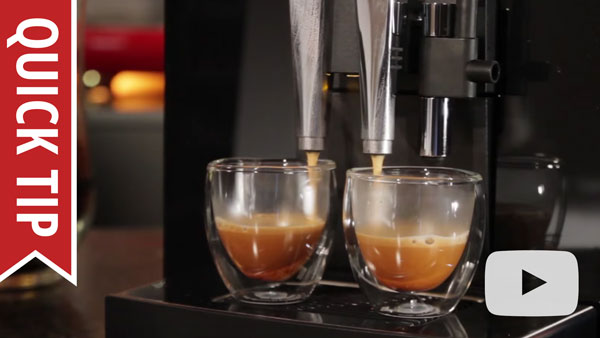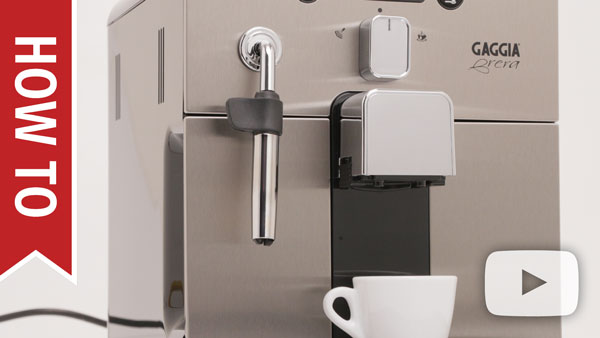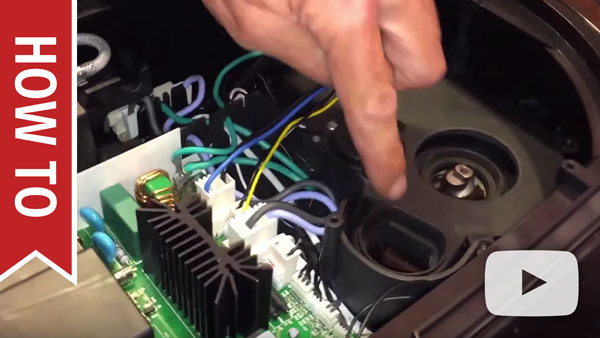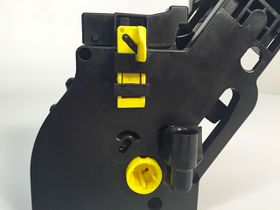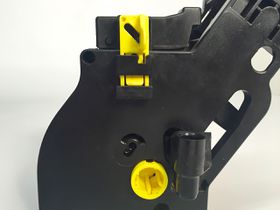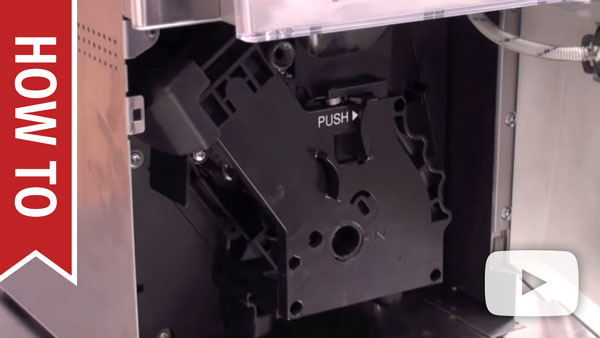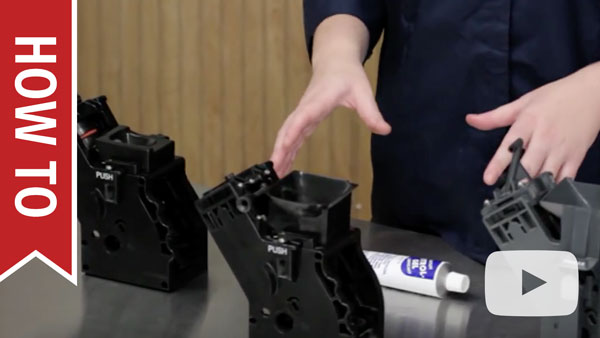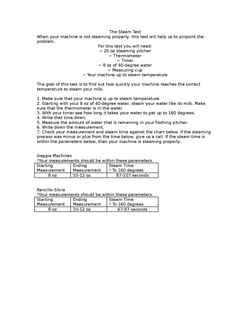Gaggia Unica/troubleshooting
From Whole Latte Love Support Library
No Crema or Bad Tasting Shots
Typically, issues with crema or the flavor of the shot do not indicate a malfunction of the machine. Instead, this indicates that an adjustment needs to be made in the brewing process or that different beans need to be used.
The type of bean that is being used is particularly important for super-automatic machines, because the built in burr grinders only accept certain types of beans. Another consideration is the roast of the bean, which greatly influences how much crema can be produced, as well as the flavor of the shot. Super-automatic machines are not compatible with oily, caramelized, or flavored beans. Properly stored and recently roasted beans are best. You can find more information on why bean selection and storage is important for super-automatic machines by watching the video below.
Appropriately adjusting the grinder is also important. Poor shots can also be the result of incorrect grind settings.
- If the shot is too bitter:
- The grind is set too fine. Try adjusting the grind to a coarser setting, typically indicated by a large dot symbol or higher number.
- If applicable, the aroma setting is set too high. Lower the aroma setting so that less coffee is ground per shot.
- The beans being used are over-roasted, and a lighter roast is needed.
- If the shot is too sour or weak tasting:
- The grind is set too coarse. Try adjusting the grind to a finer setting, indicated by a lower number. Whenever moving the grind to a finer setting it is important to make minor adjustments, and to only adjust the grinder while in operation.
- If there is little crema:
- The beans are probably stale and fresher beans need to be used.
- The grind setting does not match the drink that is being made. Smaller drinks such as an espresso require finer grind size; larger drinks such as a longo require a coarser grind.
- Oily or dark roasted beans are being used. These beans are not compatible with the unit, and are not suitable for espresso brewing. The oils and chemicals that are needed to produce a rich crema have been roasted out of the bean. Switch to a drier/lighter roast.
- Keep the machine properly cleaned and maintained for good tasting shots. Your grinder may need to be cleaned or calibrated, or you may need to descale your machine to remove any unwanted residues or flavors.
Difficulty Frothing
As with brewing, frothing is highly dependent on technique. If the machine is producing steam then an adjustment to technique may need to be made. Frothing is very sensitive to technique, so there is a steep learning curve. The video below shows proper frothing technique for pannarello style wands:
There are also common frothing mistakes which are made that will result in poor or no froth. The video below identifies these mistakes and shows how to correct them:
This machine also utilizes a special nozzle attachment called a pannarello. The pannarello nozzle needs to be regularly cleaned and properly attached to the machine in order to function. This machine uses a 3-piece style of pannarello instead of the normal 6-piece style. The video below describes how to properly clean and maintain this three piece style of wand:
Alternatively you can try frothing on the machine without the pannarello attachment. The naked wand can also produce a tight microfoam, and is preferred by some users. The major disadvantage of frothing with the naked wand is that it reduces the length of the steam wand by several inches.
Flow Issues
The first place to start with any flow issue is cleaning the machine. Before going through these steps please make sure the machine is cleaned according to the Cleaning & Maintenance section of this article.
Poor Flow, No Flow, or Alarm Light On
If only the alarm light is on steady, and no other lights are lit up, then the machine is requesting that you turn the steam knob to the closed position.
If you are not able to get water to flow through the machine at all, none of the functions flow well, or the alarm and hot water lights are on steady then there is something blocking the flow of water through the machine. The alarm light and hot water light error in particular mean that the machine is recognizing poor flow conditions and is requesting to be primed. This error typically indicates the machine is not being cleaned on a regular basis. Review the cleaning & maintenance instructions for this machine, and make sure the cleanings are being done at the suggested interval with the recommended product.
- First try priming the machine. To prime the machine simply use the same procedure as activating the hot water dispensing. The pump should begin vibrating and water should come through. The water light will clear when the machine senses water flow. Set the knob to the closed position. If the priming signal comes on again proceed to the next step. Attempt priming again after each step.
- The water tank is not seating properly. Please remove the tank and reinsert it firmly. Make sure there are no beans or debris in the water tank chamber preventing the tank from seating flush with the machine.
- If you are using an Intenza water filter in the machine then it might be blocking the flow of water. Try removing the water filter and using the machine without it. If the machine works without the water filter, then the filter was blocking the flow of water. Keep the filter out of the machine for the remaining steps.
- The machine needs to be descaled. Descaling should be done every 2-3 months with either Gaggia Decalcifier or Durgol Descaler. Scale buildup inside the machine can be very damaging and cause serious flow issues.
- A foreign body, such as coffee grounds, has gotten drawn into the system from the water tank. This kind of debris can get lodged in valves/water circuits and cause flow issues. Try cleaning the brew unit check valve using the instructions here.
- If your machine features an e-plus dial it may be clogged with scale or coffee grinds. Restart the machine. When you hear the pump start vibrating start turning the dial back and forth over and over again. The e-plus dial is the knob located right above the coffee dispensing spout that controls how quickly coffee flows out of the spouts.
No Flow From Steam Wand
Once the flow issue has been resolved the machine should be immediately descaled with the recommended product. Flow issues and blockages are typically due to lack of maintenance or excessive scale buildup.
- First remove any attachments on the wand and set the machine to hot water mode.
- Once the pump is activated turn the steam knob to the steaming position. The pump will start to vibrate and hot water should begin to flow through the wand.
- If hot water does flow through the wand stop the machine from dispensing hot water and switch the wand to steam mode to test for flow. There may have been a piece of debris in the steam wand blocking the flow of water.
- If water does not flow through the wand then there may be a more severe blockage. Proceed to the next step.
- Soak the wand in a mixture of descaler and hot water. Test flow using the hot water function again.
- Use a pipe cleaner to manually clean the inside of the wand. Only use a pipe cleaner with synthetic or plastic bristles; do not use one with metal bristles as it can damage the wand. Test the flow again.
- If none of these cleanings have resolve the behavior then there is an internal blockage, or the steam thermostat has failed. The machine will require a repair.
Reduced Or No Flow During Brewing
- If there is no flow while brewing specifically, then something is blocked along the brew circuit. Begin by running a descale of the machine using the recommended product. Scale buildup is the most common cause of flow issues. Descaling will most likely resolve the issue.
- If the machine is set to a really fine grind, the grinds can block the flow. Set the grind to a coarser setting and see if flow is restored. Leave the grind on the coarse setting for the remainder of flow testing.
- There may be an issue with the brew unit.
- First remove the unit and rinse it off with cold water. Do not use any sort of detergent or soap to rinse it off or necessary lubricant will be removed.
- Wipe down the brew unit chamber with a damp cloth to remove any leftover grounds. A microfiber cloth is best, to prevent any cloth fibers from remaining behind.
- Clean the check-valve. Here are the instructions to follow.
- Reinsert the brew unit and test for flow.
- This machine allows beverage length to be reprogrammed. Make sure it isn't set to the minimum brew length. If the machine is programmed to the minimum beverage length the machine may not dispense any coffee, or it may only dispense a few drops. Try reprogramming the machine to a longer length drink to see if it resolves the no flow issue.
- Check the brew unit to make sure it is lining up with the spout assembly and connecting with the spout assembly properly.
- If you are noticing a lot of brewed coffee or coffee sprayed inside the brew unit chamber then the brew unit o-ring may be damaged or out of place.
- Remove the brew unit and inspect the large red o-ring attached to the tamping assembly. Make sure it is clean, properly positioned, and not damaged.
- If the o-ring is broken or damaged it should be replaced. A brew unit o-ring can be purchased here.
- Your machine features an e-plus dial which may be blocked. Try brewing a shot and while the pump is activated turn the e-plus dial back and forth. This may clear up the blockage and restore flow.
- The dispensing spout may be blocked. Try very gently cleaning the dispensing spout holes with a toothpick to remove any blockages.
Have Flow But Getting No Flow Error
In some situations, you will be able to get flow through the machine for all functions, but the machine thinks there is no water flowing through. There is a device in the machine called a flow meter, and it tells the machine when water is flowing through or not. The device operates by having small fan-like blades spin when water passes through it. If those blades get stuck from excessive scale buildup or debris, then they will not spin. As a result, even though water is flowing through the machine, you will get a flow error.
If your machine uses a water filter, temporarily remove it from the water tank and add the recommended descaling product to the water tank. The descaler needs to work its way into the system to start dissolving the scale buildup in the flow meter. You may have to keep restarting the machine so that it can keep attempting to prime, which will draw the descaler/water solution into the system. If at any point you are able to clear the flow message then you will want to do an immediate descale of the machine. After you have descaled, run 4-5 tanks of plain water through the hot water function for the wand in order to ensure the system is completely free of debris.
Machine Is Leaking
From The Bottom
- Check the internal drip tray and make sure it is not overfilling. If the drip tray full indicator came on, and the trip tray was removed and reinserted but never emptied, it will reset the machine sensor and possibly result in the tray overflowing.
- The leaking is coming from the water tank chamber.
- If the water tank is not positioned properly it can cause water to continuously drain from the tank, even while the machine is turned off. This happens when the water tank is inserted far enough to open the release valve, but not far enough to seal with the intake line. This water can leak out from the water tank and end up on the bottom of the machine. This particular issue is usually indicated by lots of clear water leaking onto the counter or into the internal drip tray, even though the machine is powered off. Remove the water tank and make sure there isn't anything, such as coffee beans, which could be blocking the tank from seating properly and then firmly reinsert the tank into the machine and press firmly on it to make sure it creates a good seal with the intake line.
- If the machine only leaks while the water tank is attached, but is properly inserted, then the intake line may be broken or disconnected. This will require a repair.
- If this does not resolve the leaking, then the leaking may be coming from an internal component and the machine should be repaired.
From The Wand
If the steam wand is leaking while the machine is on and/or brewing, the steam valve is open inside the machine. It is likely that scale has built up inside the valve, and the buildup is holding the valve open. Try the following to resolve the leak:
- First begin by descaling the machine using the recommended descaling product.
- After descaling flush 4-5 tanks of plain water through the system using the hot water function for the steam wand. This will ensure any debris or scale buildup the descaling loosened is fully removed.
- If this does not work then the machine should be sent in for repair since the steam valve may need to be replaced.
Machine Not Heating Or Powering On
No Power
- Make sure the machine is plugged into an appropriate power source.
- Do not use the machine on a surge protector. This machine has a high power draw, more than a typical kitchen appliance such as a refrigerator or a microwave. Surge protectors are typically not rated to handle the amperage this machine requires.
- Make sure the power cord is firmly inserted into the power socket on the machine.
- Try using the machine on a different outlet, and make sure the machine is the only appliance plugged into that outlet.
- Try testing another appliance on the same outlet.
- Make sure the power switches are functioning properly and not broken. If the machine isn't powering on try pressing and holding the power button in the on position to see if the machine turns on. If you are able to power the machine on this way then the power switch needs to be replaced.
- If the machine recently had a leak, had water spilled on it, or any other exposure to moisture then the machine may be shorting out. Try letting the machine sit unplugged for 48 hours to make sure there isn't a short caused by moisture.
No Or Little Steam
- If you are getting no or little steam then there may just be a blockage in the steam circuit. Do the cleanings suggested in the section of this article which discusses steam wand blockages.
- Check the steam knob to make sure it is correctly positioned. If the knob spins in place and doesn't reach a stopping point then the knob may be broken, or something is disconnected in the steam valve assembly.
- Make sure to give the machine sufficient time to heat up. Even a machine that uses a rapid steam boiler will still take thirty seconds to a minute to be fully heated.
- Make sure that you are purging the steam line before frothing. Purging is an important process for any machine that has a steam wand. Since the steam leaving the boiler hits the cold room temperature wand it is going to condense back into water. Wait until there is mostly steam coming out of the wand and then close the knob. You are now ready to steam with the machine now that the line has been purged.
- If the cleanings haven't worked and there is still no steam then the machine may have a bad thermostat and it will require a repair.
Cold Shots
Make sure you are using a preheated cup. Ceramic cups will sap a lot of heat from the shot resulting in a colder shot. Preheating the cups using the machine's hot water function is suggested, or you can brew into a paper, styrofoam, or other well insulated cup. If your machine utilizes a cup warming function you can use it to preheat the cups. Alternatively you can use the machine's hot water function to fill the cup with hot water before pulling a shot to preheat it. If the shots are completely cold then the brew thermostat is broken and the machine will require a repair.
Empty Grounds Light Stuck On Or Blinking
Make sure the machine is powered on when doing these maintenance items. The various components trip sensors in the unit which tell the machine the maintenance has been done. If the machine is not powered on the sensors won't reset and the alarm light will remain on.
- The internal drip tray and grounds drawer are full.
- Remove the internal drip tray and grounds drawer.
- If the drip tray chamber is dirty or has any debris in it, wipe it down.
- Firmly reinsert the grounds drawer and drip tray into the unit.
Fill Water Light Stuck On
Make sure the machine is powered on when refilling the water tank. If the machine is not powered on the water tank sensor won't reset and the no water light will remain on.
- The water tank is empty or not inserted properly.
- Remove the water tank and refill it.
- If the water tank chamber is dirty or has any debris in it, wipe it down.
- Firmly reinsert the water tank into the machine.
No Beans Light Stuck On
The grinder may be blocked. This typically happens if beans are being used that are not compatible with the machine. This machine does not accept oily, caramelized, or flavored beans. Use of these beans can cause permanent damage to the machine that is not covered under warranty. These beans can be identified easily. They will be shiny and feel slippery or sticky. Dry beans that are appropriate for the machine will look dull and feel rough.
- Do the cleaning and calibration instructions in this video:
- After reassembling the machine according to these instructions do not add beans in. First make sure the grinder adjustment knob is set to the coarsest setting, which is the largest dot.
- Add beans back into the machine. The beans must be dry, do not add oily beans back into the unit.
- If this clears the alarm light and shots are pulling successfully on this grind setting then you can move the grind back to the original setting. Only move the knob one dot at a time, brewing a shot in between each adjustment.
Alarm Light Flashing
If the alarm light is flashing slowly, this indicates that a component of the machine is missing or not inserted properly.
- The brew unit is not inserted properly.
- Remove the brew unit from the machine.
- Make sure the brew unit chamber is clean and clear of coffee grounds or other debris. Make sure the tracks for the brew unit are not blocked.
- Firmly reinsert the brew unit into the unit. It should click into place. To test if it is properly reinserted try removing it from the machine without hitting the push/press button. You should not be able to remove it. If you can go to the next step.
- There is a flap on the back of the brew unit, opposite the side that says push/press, that needs to be in a certain position.
- If the flap is down inside the square notch like the picture below then it needs to be pushed upwards. Please note that on certain units, especially newer Gaggia unites, a yellow plastic is used instead of black plastic to help make this part more easily identified.
- The flap should look like this when it is in the correct position.
- It's possible that the gear for the brew unit is in the wrong position. This video discusses how to trick the machine into resetting the gear to the correct position:
If the alarm light is blinking quickly then the machine is sensing that the brew unit motor is working too hard to engage the brew unit. The machine will stop and give these error codes as a protective measure so that the machine does not break itself. This issue is typically resolved through normal maintenance.
- First restart the machine to clear the error message and reset the machine back to the home position so that it can be removed.
- Once the machine is restarted wait until the machine is at ready screen.
- When the machine is at the ready screen open the door of the machine.
- Try removing the brew unit. If the brew unit does not readily come out do not force it out. The brew unit is stuck in an engaged position and will need to be properly reset. Forcing it out of the machine can break the brew unit and possible damage other parts. Do the instructions in the following video to get the brew unit properly reset before moving on to the next step. If the brew unit won't reset to the home position the machine may require a repair.
- If the brew unit is easily removed then rinse it off with cold water and let it dry.
- The brew unit will need to be cleaned and lubricated using the instructions in the cleaning and maintenance section above.
- Reinsert the brew unit into the machine and try brewing a shot.
Top Lights Blink Simultaneously
These lights blinking simultaneously is a general error signal for the machine. This error signal is used as a catch-all for atypical machine errors. Do not confuse this with a similar machine signal, which is the middle row of lights blinking in rotation; this means the machine is rinsing.
- The brew unit did not engage properly for some reason. If this signal appeared when you heard the brew unit moving, then it likely has something to do with the brew unit or brew unit motor.
- Restart the machine. Sometimes this error simply means the brew unit was blocked or did not engage properly and restarting the machine will resolve the behavior.
- If the error is still occurring refer to the section of this article that discusses brew unit cleaning and lubrication. Make sure the brew unit is cleaned and lubricated according to the instructions.
- The grinder may be blocked. If you get this error when the grinder goes to activate in particular, then it likely indicates an issue with the grinder mechanism. This typically happens if beans are being used that are not compatible with the machine. This machine does not accept oily, caramelized, or flavored beans. Use of these beans can cause permanent damage to the machine that is not covered under warranty. These beans can be identified easily. They will be shiny and feel slippery or sticky. Dry beans that are appropriate for the machine will look dull and feel rough.
- Do the cleaning and calibration instructions in this video:
- After reassembling the machine according to these instructions do not add beans in. First make sure the grinder adjustment knob is set to the coarsest setting, which is the largest dot.
- Add beans back into the machine. The beans must be dry, do not add oily beans back into the unit.
- If this clears the alarm light and shots are pulling successfully on this grind setting then you can move the grind back to the original setting. Only move the knob one dot at a time, brewing a shot in between each adjustment.
- If the signal still has not cleared then there is an internal issue with the machine which will require a repair.
Brew Unit Stuck
If the brew unit of your machine is stuck in place do not try to force it out of the machine. This will more than likely result in the brew unit breaking or other damage being done to the machine. Forced removal of the brew unit can cause the machine to fail in a way that will only be able to be repaired by professional technician. Follow the instructions in the video below to get the brew unit reset to the proper position.
My Brew Unit is Squeaking While Brewing or Rinsing
If you hear a squeaking sound while brewing or rinsing, your brew unit o-ring likely needs to be lubricated. In some cases, your brew unit o-ring may need to be replaced. You can use Gaggia Food-Safe Lubricant or petroleum gel, such as Vaseline to lubricate the o-ring. Only a little bit of lubricant is needed.
The brew unit brews, as the name suggests, but, just as importantly, it's also responsible for tamping ground coffee into a consistent puck. Inside the unit are two tracks which should be lubricated every six months or so for best results in the cup. Watch the video on the right to get the low down on food safe lubricant and how to keep the brew unit functioning smoothly.
Too Much Steam/Milk Boiling
If you think your wand is producing too much steam, or your milk looks like it is boiling, then you may need to make an adjustment to your frothing technique. Boiling milk, or milk that is getting to hot before frothing is completed is an indication that incorrect frothing technique is being used. Review the section of this article that addresses frothing difficulties for more information.
If you have tried adjusting your technique and the wand still appears to be producing too much steam, then a steam test should be completed.If the machine is within the specified steam test range, then the machine is producing the correct amount of steam and an adjustment to frothing technique is necessary. Using a carafe that is chilled in a freezer before frothing is helpful for keeping the milk cooler for longer, allowing for more time to froth before the milk begins to scald.

